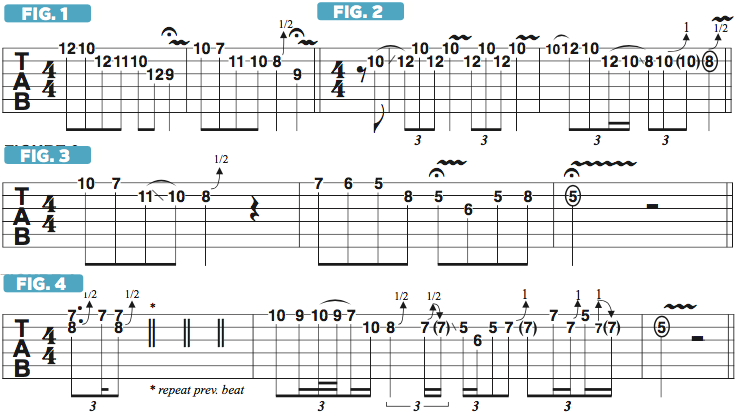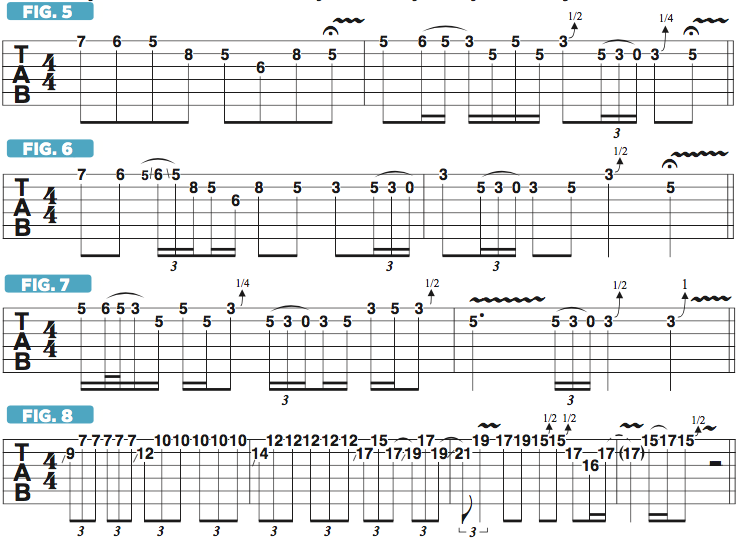How to Make Soloing Sound Cool on Just Two Strings
Two-string soloing can help force you away from the “muscle memory” licks and patterns that so many players feel trapped by.
A favorite approach of mine for thinking outside the box when soloing is to restrict myself to playing on only two adjacent strings, which ultimately forces me to move up and down the fretboard. Oftentimes when soloing, one’s lines will fall on one pair of adjacent strings, followed by another pair, then another. This would not be the case when utilizing techniques like sweep picking or playing extended arpeggio-based phrases, but the lion’s share of soloing on the guitar can be boiled down to moving from one pair of strings to another. Another great benefit of the two-string approach is that it forces you away from the “muscle memory” licks and patterns that so many players feel trapped by and are always trying to break away from.
Let’s begin in the key of E, focusing on the top two strings. FIGURE 1 illustrates two positions of the E blues scales (E G A Bb B D), starting in ninth/10th position and moving down to seventh position. Intentionally remaining on these two strings within this area of the fretboard will force us to think melodically and employ different means of articulation, such as hammer-ons, pull-offs and slides, in moving from one position to the other. FIGURE 2 offers a simple two-bar phrase, initiated by a slide up the B string, an eighth-note triplet figure and then sustained, vibrato-ed notes on the high E string. In bar 2, I use a pull-off and slide to move down to the lower position, ending with a bend vibrato. Overall, I’m looking to get the most out of the sound and articulation of each note.
Let’s now apply this approach moving between seventh and fifth positions with E minor pentatonic, as shown in FIGURE 3. FIGURE 4 offers a four-bar improvised solo that begins with a two-note pair, G and B, a major third apart, with the minor third, G, bent up a half step to the major third, G#. In bar 2, I include the major sixth, C#, in a double pull-off phrase on beat one and repeatedly bend the second, F#, up a half step to G. Notice also that I “cheated” a little and snuck in one note on the G string, C#, to help balance out the phrase.

FIGURE 5 shows the E blues scale played in fifth and third positions, and FIGURE 6 is solo phrase that moves smoothly and melodically from the higher to the lower position. FIGURE 6 takes us down to the next two lower positions of the E blues scale, fifth and third positions, and FIGURE 7 offers a melodic phrase that stays rooted in these positions.
Another approach to staying on a single pair of strings is to implement a fixed intervallic relationship between them and move it up or down the board. In FIGURE 8, notes that are minor third (three half steps) apart ascend the fretboard, staring in seventh position and moving all the way up to 19th position. Once you have these phrases memorized, strive to invent solo lines of your own that utilize this two-string approach.

All the latest guitar news, interviews, lessons, reviews, deals and more, direct to your inbox!
Guitar World Associate Editor Andy Aledort is recognized worldwide for his vast contributions to guitar instruction, via his many best-selling instructional DVDs, transcription books and online lessons. Andy is a regular contributor to Guitar World and Truefire, and has toured with Dickey Betts of the Allman Brothers, as well as participating in several Jimi Hendrix Tribute Tours.

